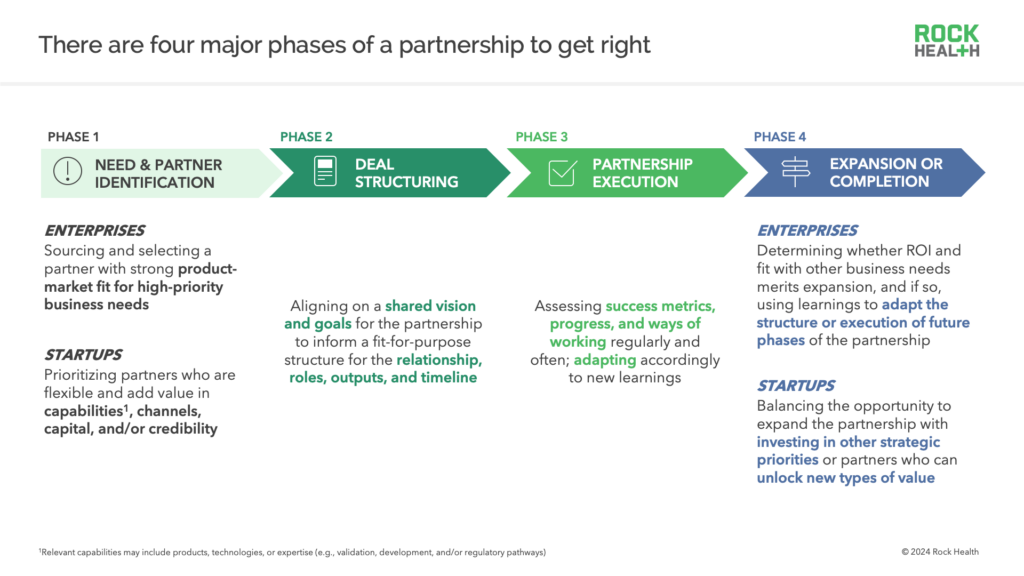Rubber, meet road: Operationalizing digital health partnerships
Thank you to Rock Health Advisory Member CVS Health Ventures for their support and collaboration on this work.
More than 2,000 digital health partnerships have been inked since 2020, according to Rock Health’s Digital Health Partnerships Database.1 That’s more than a partnership a day—for nearly five years straight. While many of these partnerships will result in improved or novel solutions, new joint ventures, or expanded channels for consumer access, many will fail to realize their envisioned goals and deliver a return-on-investment. So what makes or breaks a successful digital health partnership?
To unpack this question, Rock Health Advisory and CVS Health Ventures partnered to host an interactive Innovation Studio: “Rubber, Meet Road: Operationalizing Digital Health Partnerships.” We convened ~50 Rock Health Advisory’s enterprise clients and startup leaders from our ecosystem for a morning of shared learning, including frameworks highlighting tactical best practices, fireside chats exploring real-world application of these principles, and breakout discussion groups to translate them into participants’ unique contexts.

Below are some of the key insights gleaned from the event.
At a high-level, there are four major phases of a partnership to get right, with some unique considerations for enterprises and startups during each phase:

Nailing each phase of this lifecycle requires thoughtful planning, alignment, and agile adaptation on the part of both partners. But to do so in a tactical and specific way, a six-point framework is required. Laying out the six categorical domains of potential partnership challenges and considerations can help facilitate both partners’ individual and joint planning processes and optimize chances of delivering the intended ROI:
- Vision and goals: Defining a clear vision for what success means to each partner, and aligning on a detailed approach and roadmap for achieving those goals
- Operating and governance model: Structuring teams effectively, creating “rules of the road” for decision-making and reporting, and holding checkpoints that advance shared goals
- Financial arrangements: Estimating costs for each deliverable or milestone and aligning on who will foot the bill for each
- Measuring success: Establishing key performance indicators to measure outcomes and track results regularly to enable required adjustments
- Data exchange and IP ownership: Aligning data governance teams and processes to enable smooth and bi-directional flow of required data; defining IP ownership early and clearly
- Ways of working and culture: Understanding working norms and communication styles, and investing in internal mechanisms and processes for engaging external innovation
Two fireside chats dug into the details of how real-world partners are implementing tactical best practices across each of these domains. In the first of these chats, CVS Health Ventures and Thyme Care homed in on operating model considerations in the partner identification phase, highlighting the importance of being picky about working with the right partner.
“Finding a partner who has done a similar partnership before in a different clinical specialty and can point to a prior contract structure and operating model that worked well for that particular partner is a key opportunity to trim down the timeline of the partnering process.”
—Julia Ivanova, SVP of Growth & Partnerships, Thyme Care
The two experts also double-clicked on ways to preempt potential ways of working and operating model challenges during partnership execution.
“Building connections between the strategy, operations, and clinical stakeholders across our organizations helped get folks to buy into the investment and ensure the longer-term relationship was prioritized.”
—Alyssa Reisner, Partner & Executive Director, CVS Health Ventures
In the second chat with Sutter Health and Abridge, a central theme was stage-gating partnerships in a “crawl, walk, run” approach that generates quick wins and enables time to iron out kinks in a focused, lower-risk sandbox while expanding scope or goals over time.
“We started by deploying Abridge to a diverse cohort of clinicians across Sutter Health, including doctors, nurse practitioners and physician assistants from both primary and specialty care. Working with our early adopter clinicians helped us uncover and address opportunities around training, consent, technical infrastructure, getting the right teams from both sides in place, and overall operations. Our partnership with Abridge to innovate within a smaller cohort has provided us with valuable learnings that we are now leveraging as we expand across the system.”
—Rahul Joglekar, Director, Design & Innovation, Sutter Health
Another key ingredient to their success was building user-first thinking and empathy into their processes for rollout, feedback, and co-design and -development.
“There’s a lot of hubris in Silicon Valley around thinking that “if you build it, they will come.” In healthcare, we have seen a lot of technology being done to clinicians, not for them. We were very intentional and explicit in our goal to build with clinicians, really understanding what their workflows look like to make our core, integrated product better and further Sutter’s goals to deliver great care.”
—Julia Chou Chapin, Chief Operating Officer, Abridge
If we’ve learned anything from the choppy, post-pandemic waters in digital health, it’s to avoid conflating volume of activity (e.g., venture funding dollars, new partnerships) with quality of activity (e.g., unit economics and time-to-profitability, ROI of partnerships). Achieving real ROI requires disciplined execution at each phase of the partnership journey, and balancing structure and planning with flexibility and iteration. By embracing an anchored yet adaptive mindset, organizations can ready themselves for the inevitably unpredictable obstacles and road conditions when the rubber hits the track.
Rock Health Advisory works with dozens of leading enterprises each year to identify winning opportunities at the intersection of healthcare and technology and connect the dots along their innovation journey. We help create successful partnership strategies by identifying and selecting the right partners and providing guidance on best practices to execute and deliver real ROI. Reach out to the Advisory team to learn how we can support you on your healthcare innovation priorities.
Footnotes:
- Captures a wide array of digital health partnership activity but not fully exhaustive

